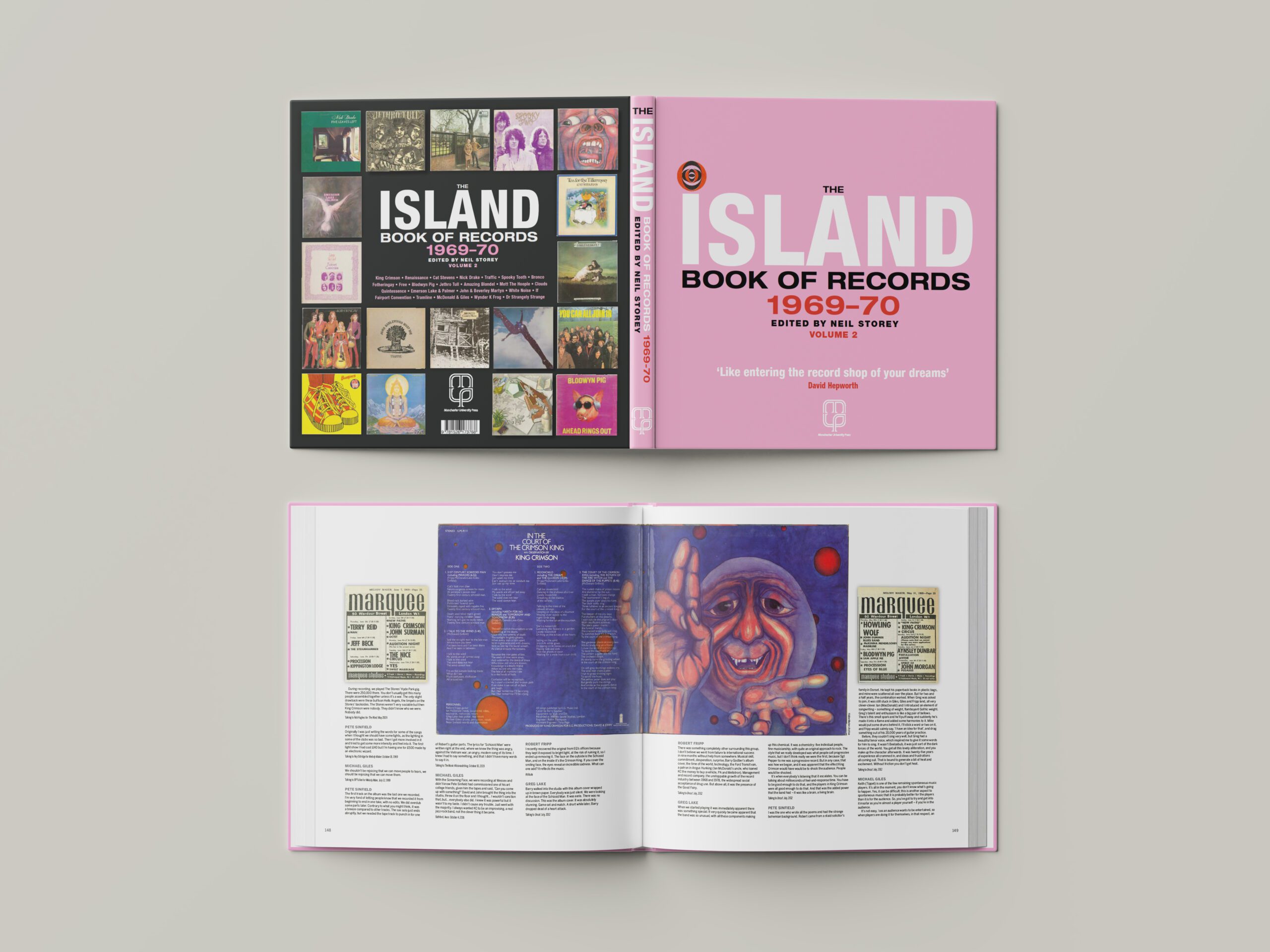
We are pleased to share this interview with Neil Storey below, as well as a playlist of songs from the special era documented in The Island Book of Records: Volume 2, available now from Manchester University Press.
This new volume documents an influential period in popular music, and rock and roll. By the end of the decade, Island was emerging as a major label, one that could boast releases from artists like Jethro Tull, Nick Drake, King Crimson, Traffic, Emerson, Lake & Palmer, John and Beverley Martyn, Fairport Convention, Spooky Tooth, and Cat Stevens.
The Island Book of Records: Volume 2 is lavishly illustrated with over 1000 images, including gig adverts, concert tickets, posters, flyers, international LP variants, labels, LP and 45 adverts, and other ephemera—making this a music collector’s dream.
 “I visited Basing Street quite a lot during those early years, sometimes interviewing various people and other times just hanging out, occasionally in the studios. The buzz was terrific….Nothing so perfect lasts for ever, but in this volume of his epic and invaluable series—expensive but, to those with an interest, worth every penny—Neil Storey catches it in glorious ascent.”
“I visited Basing Street quite a lot during those early years, sometimes interviewing various people and other times just hanging out, occasionally in the studios. The buzz was terrific….Nothing so perfect lasts for ever, but in this volume of his epic and invaluable series—expensive but, to those with an interest, worth every penny—Neil Storey catches it in glorious ascent.”
—Richard Williams, The Blue Moment
“This brand of artistry which has its roots in such storied, handcrafted works as the Book of Kells, is richly and newly evoked in such coffee table treasures as the Island books. A kaleidoscopic two-volume tapestry spanning (thus far) 1959-1970 in pop music history, it’s a seemingly immense labor that Neil and a tight cadre of colleagues have stuffed with evocative art in the form of photos, handbills, and skeins of reflective quotes from those who were there.” –Fred Schruers, Dogtown
The book is filled with behind-the-scenes stories. Can you share one surprising or little-known anecdote that readers will discover?
There are so many, it is genuinely hard to choose because almost every album has something of a surprise attached to it. Examples (plural) would include Chris Wright, the co-founder of Chrysalis talking about his role in the creation of the first Blodwyn Pig album cover – an image which features a pig’s head smoking a joint wearing dark glasses and headphones. Then there is Chris Blackwell explaining why he didn’t want to sign Cat Stevens and the song which changed his mind. And then, on discovering that Cat Stevens was signed to Decca (Deram) the ruse he suggested which would free Stevens from that contract (it worked too). There’s the tale behind the empty place settings on the back of Fairport Conventions’ Unhalfbricking album cover… and the story of why the album was called that in the first place. And… why the world-renowned Japanese photographer Hiroshi Yoda only shot two album covers in his career… and both were for Island.
Music fans love album cover stories—I’m thinking of the Beatles’ butcher cover for Yesterday and Today, and Nirvana’s Nevermind, as two mythic examples. The Blind Faith cover remains controversial—what’s your take on its legacy and how it was received at the time?
At the time? People who bought it (like myself) didn’t bat an eyelid… the fact it had a pubescent girl topless on the cover didn’t really register. I certainly don’t recall thinking of it as being phallic – which it was accused of. Or titillating. Because, it wasn’t. Besides, it was issued not long after Jimi Hendrix’s Electric Ladyland and that had twenty or so nude women across its gatefold cover. Personally, I don’t think its that great an album cover – its ok but not outstanding. Its legacy? A bit of a fuss over nothing and an album which, musically, promised more than (I felt) it delivered. Now… if Clapton had joined Chris Wood, Steve Winwood and Jim Capaldi – the nucleus of Traffic – that would have been really interesting.
From your research and interviews, what was the most unexpected challenge Island Records faced during this golden era?
Probably… not trying to run before it could walk. In time, the label did outgrow itself and started releasing records which, quite frankly, should have never been considered in the first place meaning it lost sight (to a degree) that less really can be more. In the two years covered by IBoR 2, there’s hardly a duff album issued… and some which sold barely a handful then are now – and rightly – regarded as masterpieces. Nick Drake’s Five Leaves Left being ample testimony to that.
You came to work at Island just a few years after the period this book covers. In your research, did you uncover anything that challenged your own memories and experiences of the label or the music industry at the time?
That’s the problem with being born two or three years late(r). I’d love to have been part of Island during the ‘pink’ era… but I wasn’t. But… I was buying as many albums as I could afford and every Island album issued became part of my collection if not on the day of release, certainly within a few months – I developed my Island-completist mentality alarmingly early. I didn’t have any experience of the music industry at that time therefore there was nothing to challenge; the only thing I couldn’t figure out was why an album was announced and then not released. That just didn’t make any sense to me – queuing up to get my money back from the never-released live Traffic album was a particularly low point.
Island Records was known for its willingness to take risks on eclectic artists. Perhaps it’s a leading question, but do you think that spirit still exists in today’s music industry?
No, I don’t – not particularly across the industry as I see it. Within what I call new-Island… I think there may be. You see, whether we like to acknowledge it or not, there will never be another era within music that is comparable. It was like the perfect storm… everything aligned at one time: technological advances hand in hand with unprecedented levels of creativity. So, trying to compare now and then is almost impossible.
During my time at the label, Island was at the very forefront of giving artists creative freedom and allowing them time to develop. A perfect example would be Robert Palmer. Chris Blackwell signed The Alan Bown because Robert had become their singer, replacing Jess Roden who he’d also signed. Robert left before Listen, the first Island Alan Bown album was released which resulted in his vocals being re-recorded when he joined Dada which mutated into Vinegar Joe which CB also signed to Island. Because of Robert. Live success for the Joes never really translated into record sales and after three albums Robert finally went solo. Then… it took the better part of five albums before Robert gained the level of chart success – initially in Europe and not the UK or the US – that he is now known worldwide for.
So… was it a risk signing Robert all those years before? It was certainly risky financially as he was running up the bills long before any significant return was seen. We at Island and especially CB believed in him… in this day and age, he’d (very probably) have been dropped long before he had hit records… just as it was mooted that U2 should be after the non-success of their second album, October. That they weren’t was down to small handful of people at the label who stood up for them. The emphasis within these two (among very many other) examples is… total belief in the act. Every label will tell you they believe in this or that act… until the bean-counters take stock and then, magically, that belief can evaporate like sunshine melts away morning mist.
Island grew a reputation for being a label which would go the extra mile. Within Island as it is now – and don’t forget just how much water has flowed under that bridge in particular – there are some who I honestly believe feel like that. They really care.
CB once said, ‘The major labels are like supermarkets, I prefer to think of Island as a very classy delicatessen’. That, for me, sums up the Island ethos perfectly. I mean… who would you rather work for?
What are you listening to right now?
Unhappily, it is the soundtrack to a world twisting on its axis in ways which are as much unimaginable as the consequences are unthinkable.
And quite a lot of Miles Davis. As well as some quite obscure reggae.
Neil Storey has spent over fifty years at the heart of the music industry. He joined the Island sales force in 1974 before going on to co-run the press office into the mid-1980s. With long experience as an editorial and events consultant, he researched and wrote The Island Book of Posters (edited by Tim Clark) and founded bespoke re-issue label Hidden Masters in 2008. He is based in France.

